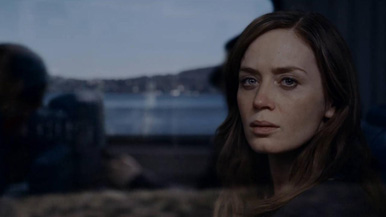Movie Review: The Girl on the Train
By Matthew Huntley
October 18, 2016
BoxOfficeProphets.com

Based on the best-selling 2015 novel by Paula Hawkins, the film's unabashedly juicy plot follows three different women whose lives are connected by...well, if I told you that, it'd be doing the movie a disservice, because one of its engines is revealing just how these women intertwine, so I'll refrain from giving away too many details. What I can tell you is the titular character, Rachel (Emily Blunt), commutes from a suburb located on the Hudson River to Manhattan every day, even though she has nowhere to be. She's an unemployed divorcee in her mid-30s who currently lives with her college friend, Cathy (Laura Prepon). She's perpetually drunk (which led to her being fired from her job) and she suffers from blackouts. On the train, she draws and drinks from a water bottle filled with vodka.
The reason Rachel rides the train every morning is because it passes her old house and she's able to observe her ex-husband, Tom (Justin Theroux), and his new wife, Anna (Rebecca Ferguson). Anna is the second major female character in this story, and unlike Rachel, Anna was able to conceive a child and she and Tom now have a baby daughter named Evie. Following a disturbing incident involving Rachel and the baby, along with Rachel's supposedly incessant text messages to Tom, Anna believes Rachel is a threat to her and her family.
You'd think Anna would be more concerned about Megan (Haley Bennett), the buxom, blonde twenty-something who currently works as Evie's nanny. She lives down the street from Tom and Anna with her husband Scott (Luke Evans), and even though Rachel doesn't know them, she also watches Megan and Scott because, based on the affection they show each other, she considers them "the perfect couple; the embodiment of true love."
But one of the recurring themes of this story, like so many stories of this nature, is that things aren't always what they seem, and we start to learn that Megan has a complicated history of her own, which she discusses with her therapist, Dr. Abdic (Edgar Ramirez), whom she's trying to seduce. And just like everyone else, she also carries a heavy secret.
Once its flawed characters and their peculiar, deplorable and often lewd behavior are in place, The Girl on the Train strives to become a classic, scandalous mystery by adding a missing persons case to the mix, which coincides with Rachel blacking out and waking up covered in blood and mud, unable to remember what happened the night before. Who goes missing, I won’t say, but from here on out, the question driving the plot is whether or not Rachel is guilty of something horrific or a victim herself. The narrative jumps back and forth between the past and present until everyone's dirty laundry is aired out and we learn who the real bad person is. And it just wouldn’t be a mystery if there wasn’t a suspecting detective, this time played by Allison Janney, who lends a good amount of dynamism to an otherwise archetypal role.
I admit The Girl on the Train is often a fun watch. Its devilish themes and sensational subject matter are likely what made Hawkins' novel so successful and these same qualities keep us engaged throughout most of Tate Taylor's film. But sooner or later, the spiciness of the plot has to give way to longer-lasting substance, or at least more than it started out with, and I'm afraid The Girl on the Train falls short in this regard.
Not that the cast and filmmakers don't try, especially Emily Blunt, who's convincing and sympathetic as Rachel. She takes her role seriously and gives her character unexpected weight and dimension, so much, in fact, she raises the bar and practically dares the rest of the movie to come up to her level. In fact, all three actresses do, and it’s their conviction and raw emotion that make us wish Erin Cressida Wilson's screenplay didn't take such drastic dives into absurdity, because the discrepancy between the genuine performances and trivial script leave us with a feeling of "what it could have been" and we feel betrayed.
I have not read Hawkins' book, but I do know many of the events in the film are taken directly from it, but what always reads well in literature doesn't necessarily adapt well on film, or at least not here. With greater subtlety, I believe The Girl on the Train could have been juicy yet still remained grounded and credible. But by the end, it descends into a blatant, misandrist farce, and instead of being entertained by it, we dismiss it as nugacity. Two objects, if you will, illustrate just how far the film is willing to go to generate shock and relay its messages: a corkscrew and the Untermyer Fountain in Central Park's Conservatory Garden. If you decide to see the movie, you'll see how these undermine the film’s integrity, even in the outrageous universe of erotic thrillers.
Based on this adaptation, I suspect Hawkins' novel was meant to serve primarily as a page-turner, which is fine (after all, who doesn't love a good page-turner?), but even a page-turner needs to stay within certain limits of reality, as does the corresponding movie. The filmmakers should have drawn inspiration from the cast and placed substance above sensation to create a more worthwhile experience. The Girl on the Train has us in small stretches, but it eventually loses us, and it’s in a big way.